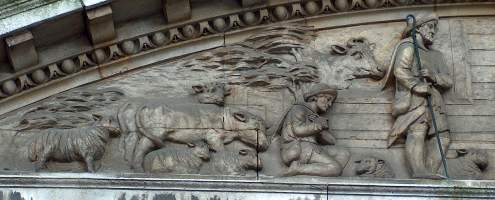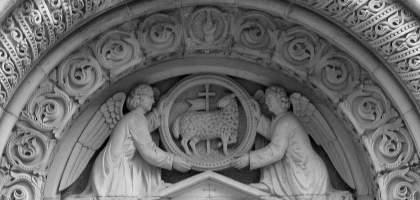

Sculptures of sheep do not, on first thought, perhaps seem very likely, but while it would be difficult to maintain they hold any great place in British sculpture, they are by no means unknown in Victorian England and earlier.
We associate the sheep with mildness, so that as an allegorical animal, it is found in a variety of religious contexts; the example below left, from the pediment of a classical church, is not untypical. We see an Adoration of the Shepherds scene, with one standing and several reclining sheep, also three cows, as well as shepherds, one with a crook. We note the sheep are rather woolly, shown by stressing the folds in the fleece - it works rather well considering that wool is not the easiest material to render in stone. An alternative religious appearance of the sculptured sheep, more frequent on church monuments, is a statue of Christ with sheep, indicative of Christ as shephard of his Christian flock. As allegory, then, we can skip the figure of Christ entirely, and just have the sheep with a crucifix, as in the tympanum of this church in Manchester, shown below right.
Another use of the allegorical sheep sculpture is to indicate pastoral life, as in the terra cotta panel below, where the reclining figure is seen in front of a minimalist landscape, with rolling hills, setting sun, and a group of sheep. The pediment group below centre is a later example from well into the 20th century; the nude couple recline, he grasping a wreathed spear indicative of peace, with growing corn behind, she holding up a ripe pear and a bunch of grapes, as a symbol of the fruits of peace. There is always a risk, with such groups, that the viewer might take the group as an allegory of fertility or abundance, and so the sheep, by placing the group as a pastoral one, may be a way of bringing us back to the intent of the allegory. Our sheep here stares fixedly at the fruits, adding a touch of levity to what might otherwise be a too self-important group. We note that the sheep fits nicely into the acute angle of the pediment, and there are other pediments where the sheep is used as a decorative element in this way, as in the example below right. This last example has shorn sheep, while that in the centre renders the woolly flanks almost like human hair, with wavy locks to give a rough and varied surface; it contrasts with the very stylised treatment of the hair on the humans.
The sheep can also feature in allegorical groups of Australia, along with the kangaroo, and recalling one source of Australia's prosperity in its early days. The example which immediately springs to mind is the Australia Gate of the Victoria Memorial, London, which has a Merino ram, bulbous with hanging wool, below left. The sheer mass is almost too much, and the effects of time on this exposed group have made the appearance of the fleece rather less convincing than it may have looked when less worn. The Australasia group on the Foreign and Commonwealth Office in Whitehall, below centre, has two sheep crowding in on the right hand side. The more fully seen animal has the lines to show creases in the fleece, while the other, where we see only the head, uses a more human-hair like treatment. One of the groups by Harold Parker on Australia House in the Strand has a fleece and a ram's read rather than a full sheep, below right.
Below is a splendid sheep by John Thomas, as part of one of the groups on the Manchester Free Trade Hall, which represents Agriculture (see here for several other examples of Allegorical sculpture of Agriculture). The sheep here has a rather medieval appearance, with its long head, anthropomorphic pose of the head, and extreme woolliness, not at all like human hair. Next to this is an engraving of a sculptured panel depicting sheepshearing, dating from the 1870s. The sheep is very naturalistic in pose and treatment; the shearer, by contrast, is shown as a heroic, idealised figure.
The sheep appears not infrequently in heraldic sculpture, as in this early example as a keystone, holding a flag somewhat awkwardly with its front leg, below left. The ringlets of wool work well both naturalistically and stylistically. Another sheep with flag is shown below centre, this being part of the coat of arms of Preston. The coat of arms with fierce heraldic lions below right has a knight's helm on top of the central shield, and a sheep is seated with crooked leg on top of this - this is the coat of arms of the Drapers Company. H. A. Pegram was the sculptor.
Sheep have endured in popularity into modern times, including in religious settings, as in the Lamb of God. As a different religious example, below is a group of sheep with shepherd, in the sense of 'the Lord is my Shepherd'; the work stands in Paternoster Square, to the north of St Paul's Cathedral, and is actually entitled Paternoster, i.e. 'Our Father'. This sculptural group was commissioned by Paternoster Development Ltd and re-emplaced in 2003 by Mitsubishi Estate - three cheers for enlightened corporations supporting public sculpture. The four sheep are a bit odd in proportion, left rather sketchy in finish, but in pose and character exude an essence of sheephood. The head of the shepherd immediately identifies the sculptor as Elizabeth Frink.
Elizabeth Frink's sheep in Paternoster Square.
We end with three examples of more minor sheep sculpture. Below left is a pediment or tympanum with central eagle, and a sheepskin with full head to left and right, to give a slightly disturbing aspect, albeit making a fine and rather novel curved side to the central feature. Below centre, we have a panel with a head of a sheep, of the moufflon variety, as a motif here associated with hunting (you will need to click on the picture to enlarge to see it properly). The horns are grand, but the forward facing view is somewhat unsatisfactory. Better is the final example, below right, from Liverpool, where the sheep is trying to force its way forward over the top of the scrolly cartouche. There is something compelling about this sculpture, in epitomising the stubborn animal pushing relentlessly in an attempt to get through a too-small hole.
Visits to this page from 13 Mar 2014: 8,642
Goat sculpture // Lion sculpture // Other animal sculpture // Allegorical sculpture